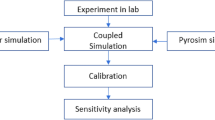Abstract
Building evacuation simulation allows for a better assessment of fire safety conditions in existing buildings, which is why it is of interest to develop an easy-to-use Web platform that helps fire safety technicians in this assessment. To achieve this goal, the geometric and physical representation of the building and installed fire safety devices are necessary, as well as the modelling of occupant movement. Although these are widely studied areas, in this paper, we present two new model approaches, either for the physical and geometric representation of a building or for the occupant’s movement simulation, during a building evacuation process. To test both models, we develop a multi-agent Web simulator platform. The tests carried out show the suitability of the model approaches herein presented.
Access this chapter
Tax calculation will be finalised at checkout
Purchases are for personal use only
Similar content being viewed by others
References
Neto J, Morais AJ, Gonçalves R, Leça Coelho A (2019) A multi-agent system for recommending fire evacuation routes in buildings, based on context and IoT. Commun Comput Inf Sci:343–347
Ribeiro J, Almeida JE, Rossetti RJF, Coelho A, Coelho AL (2012) Towards a serious games evacuation simulator. In: TroitzschKG, Moehring M, Lotzmann U (eds) ECMS 2012 proceedings
Coelho AL, Neto J (2020) A importância da modelação das condições de segurança ao incêndio na reabilitação de edifício. In: Livro de Atas do ENCORE 2020 - 4° Encontro de Conservação e Reabilitação de Edifícios, pp 345–356
Gwynne S, Galea ER, Owen M, Lawrence PJ, Filippidis L (1999) A review of the methodologies used in the computer simulation of evacuation from the built environment. Build Environ 34(6):741–749
Hamacher HW, Tjandra SA (2001) Mathematical modelling of evacuation problems: a state of art
Schadschneider A, Klüpfel H, Kretz T, Rogsch C, Seyfried A (2011) Fundamentals of pedestrian and evacuation dynamics. In: Multi-agent systems for traffic and transportation engineering. IGI Global, Hershey
Dhamala TN (2014) A survey on models and algorithms for discrete evacuation planning network problems. J Ind Manag Optim 11(1):265–289
Kobes M, Helsloot I, de Vries B, Post JG (2010) Building safety and human behaviour in fire: a literature review. Fire Saf J 45(1):1–11
Ronchi E, Nilsson D (2013) Fire evacuation in high-rise buildings: a review of human behaviour and modelling research. Fire Sci. Rev. 2(1):7
Leça Coelho A, Neto J (2019) Modelo de Análise das Condições de Segurança ao Incêndio em Edifícios Existentes (MACSI_2E), Lisboa
Author information
Authors and Affiliations
Corresponding author
Editor information
Editors and Affiliations
Rights and permissions
Copyright information
© 2023 The Author(s), under exclusive license to Springer Nature Singapore Pte Ltd.
About this paper
Cite this paper
Neto, J., Morais, A.J., Gonçalves, R., Coelho, A.L. (2023). Geometric and Physical Building Representation and Occupant’s Movement Models for Fire Building Evacuation Simulation. In: Yang, XS., Sherratt, S., Dey, N., Joshi, A. (eds) Proceedings of Seventh International Congress on Information and Communication Technology. Lecture Notes in Networks and Systems, vol 448. Springer, Singapore. https://doi.org/10.1007/978-981-19-1610-6_67
Download citation
DOI: https://doi.org/10.1007/978-981-19-1610-6_67
Published:
Publisher Name: Springer, Singapore
Print ISBN: 978-981-19-1609-0
Online ISBN: 978-981-19-1610-6
eBook Packages: EngineeringEngineering (R0)




